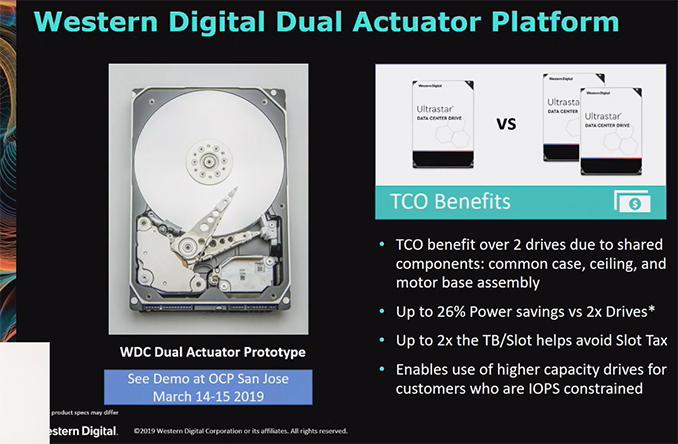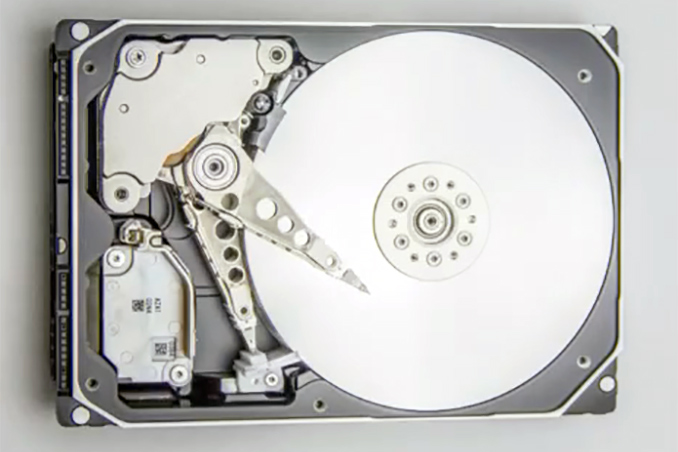Western Digital to Demo Dual-Actuator HDDs Next Week: Double the Actuators for Double the Perf
by Anton Shilov on March 8, 2019 12:00 PM EST- Posted in
- HDDs
- Storage
- Western Digital
- Dual Actuator HDD

Western Digital has revealed this week that it will demonstrate its first dual-actuator hard drives at next week's OCP summit. Marking the company's first foray into multi-actuator drives, WD expects their dual-actuator HDDs to offer roughly twice the performance of conventional, single-actuator drives, although they'll be trading off some power efficiency in the process.
While the capacities of enterprise and nearline 7200-RPM hard drives has been increasing consistently, due to the laws of physics the I/O performance of these drives has remained at around 80 IOPS per drive. This means that because capacity has gone up, the drives' IOPS per TB performance ratio is decreasing, something that is especially problematic when it comes to read IOPS. As a result, it is getting harder for datacenter operators to meet their service level agreements and quality-of-service requirements.
To combat this, one of the most straightforward ways to increase drive performance and throughput is to increase the number of individual actuators, allowing drives to essentially service twice as many I/O operations at once. Both Seagate and Western Digital have been developing their multi-actuator HDDs for quite a while. The former demonstrated a working dual-actuator drive last March, whereas the latter will show off its dual-actuator prototype next week.
Western Digital has rather high expectations for its dual-actuator HDDs. The company expects the new drives to offer double the sustained transfer rates as well as double the IOPS when compared to existing HDDs. Which if we use existing drives as a baseline, would mean that we're talking about data rates on the order of 500 MB/s as well as 160 ~ 200 IOPS. Meanwhile, although no official numbers were provided ahead of next week's formal reveal, the company did publish a photo of its dual-actuator prototype.
The trade-off for dual-actuator technology is that since these hard drives are essentially two HDDs in a single chassis, they will consume more power than traditional drives. But it's still 26% less than two independent HDDs, owing to the fact that it's still a single set of spinning platters. For example, Western Digital’s Ultrastar 14 TB SATA hard drive consumes 7.6 W in operating mode, and a pair of such HDDs would be 15.2W. Meanwhile, a hypothetical dual-actuator hard drive that consumes 26% less than these two would end up at around 11.25W, which, importantly, is within power limits of a typical 3.5-inch SATA bay (typically up to 12 W).
Right now, Western Digital is not disclosing when it intends to commercially release its dual-actuator HDDs. Instead, the company is stressing right now that it is only talking about a technology demo. Nonetheless, we hope the company will make its plans a bit more clear next week.
Related Reading:
- State of the Union: Seagate's HAMR Hard Drives, Dual-Actuator Mach2, and 24 TB HDDs on Track
- 16 TB MAMR Hard Drives in 2019: Western Digital
- Seagate’s Multi Actuator Technology to Address HDD IOPS Woes
- Western Digital Stuns Storage Industry with MAMR Breakthrough for Next-Gen HDDs
Source: Western Digital at Storage Field Day (via ComputerBase)











23 Comments
View All Comments
Gasaraki88 - Monday, March 11, 2019 - link
This will increase sequential performance also because this is essentially RAID 0 in one drive.Kevin G - Friday, March 8, 2019 - link
What is old is new again. Conner had this technology a long time ago:http://mydatarecoverylab.com/history-repeating-mul...
Seagate has no issues bringing forward a drive as they purchased Conner in the 1990's as they got most of the patents around this idea. Western Digital had to wait for these patents to expire before moving forward (they have been expired for several years now). It would be odd to see Western Digital release a dual actuator drive before Seagate given history.
As for power consumption, the saving between two drives likely stems from there only being one motor spinning the platters and common PCB. I suspect that from a performance/watt perspective, these drives will be major winners.
Death666Angel - Friday, March 8, 2019 - link
We've had electric cars in the early 1900's. But they weren't very feasible then. Due to several factors, they are now. Same with this idea. And probably 20 years from now when we get technology into everybodys hands that is in some labs right now but just not feasible for large scale deployment. That is how technology has always been. This isn't some big revelation.vishnumrao - Friday, March 8, 2019 - link
All the innovation on this tech probably comes from the HGST side that they bought sometime earlier this decade. HGST was first to develop Helium hdds for the data center and enterprise market. WDC's strength had been the mobile and desktop markets.29a - Friday, March 8, 2019 - link
Will these drives have a higher failure rate similar to RAID 0?Death666Angel - Friday, March 8, 2019 - link
Since not every failure point is double like it is in RAID 0, no. But since there are more failure points than in standard drives, it is likely that the failure rate is higher (unless they do more binning and tuning). Eventually, it will probably be pretty much identical, unless you purchase quantities in the thousands or hundreds of thousands.FunBunny2 - Friday, March 8, 2019 - link
failure, i.e. head crash, would likely be the same, since there are the same number. the only active part that is doubled, may be, is the voice coil(s). what proportion of HDD failures are the VC? or are there more extra active parts?PeachNCream - Friday, March 8, 2019 - link
To an extent, the performance of dual head (yup, just like my VCR) drives can be simulated by building a two drive RAID 0 array with an admission that there are obviously going to be some differences. I'm not saying this isn't worth doing, but I do worry that there isn't a lot of performance gain left on the table for mechanical drives even with a second actuator when compared to solid state solutions. I guess there's a cost per capacity advantage, but it looks like there is a certain amount of erosion of that advantage as SSD prices have fallen quite a bit and mechanical drive research looks like its lagging a bit.GregBulmash - Friday, March 8, 2019 - link
Considering you can get a 2TB 2.5" SATAIII SSD drive for under $250 lately and it's both just as fast or faster AND only due to come down in price, the argument makes sense for personal computing.But there are two places these drives can still win. Price per terabyte, especially in combination with terabytes per cubic inch. If a 12TB model sells for $1200, its single 3.5" bay is less than the three 2.5" bays needed for $2100 worth of 4TB SATAIII SSDs. That makes these still worthwhile in datacenter uses.
ksec - Friday, March 8, 2019 - link
That has a potential 1GB/s in Raid 0. We seriously need 5Gbps or even 10Gbps Ethernet networking equipment price to drop.